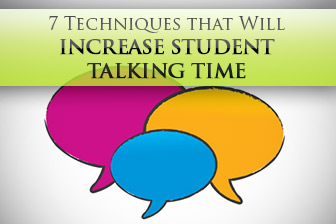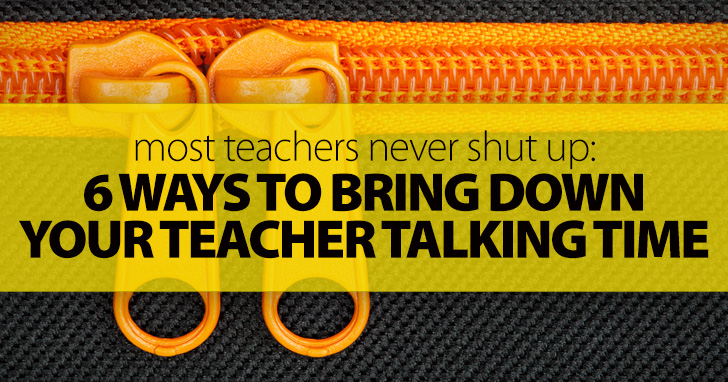7 Techniques that Will Increase Student Talking Time – Exponentially!


I first tried this during my CELTA qualification, way back in 1999, and was amazed at what I found. There were some good things – the atmosphere was active and noisy, the students spoke entirely English, and there was a good amount of production going on – but I noticed one thing which stopped me cold.
I never, ever shut up. Not even for a minute.
I’m a talkative guy anyway, but this was a real problem in the classroom. It sounded as though I believed the only way to conduct a class was verbally, and the most important, the most knowledgeable, and the funniest voice was always going to be mine.
I’m happy to admit that I was quite wrong, and I’d like to share some ways of bringing down your Teacher Talking Time (TTT). This way, the teacher relinquishes the center of attention, providing more practice time for the students.

Here are two real examples. The first is by a relatively new teacher who was actually interviewing for a job at my school. Unfortunately, she was not chosen, but can you see why?
***
| Teacher: | Good morning! Today I’m going to talk to you about making friends from other countries. |
| Students: | OK! / Great! |
| Teacher: | I have lots of friends from other countries, because I’m curious about other languages and cultures. I think they’re fascinating. [Draws a quick cartoon of herself on the board, linking it to other, small cartoons of her friends]. This is Pedro, my friend from Spain. He’s an architect. [Draws a house next to the cartoon of Pedro.] And this is my best friend. Her name is Selene and she’s from Peru. Right now she’s a student, like you guys. [Draws a scholar’s cap on the cartoon of Selene]. |
| Students: | [Some giggling at the cartoons.] |
| Teacher: | So, how did I make all these international friends? Well, I like to friend people on Facebook. I have nearly seven thousand Facebook friends now, but I want a lot more! [Writes ‘7,000 friends’ on the board under the cartoon of herself.] |
| Students: | Wow! / Is a lot / Seven thousands! |
| Teacher: | Do you use Facebook? |
| Students: | Yes! / No really / Is passed now, I like [names a social media site from home]. |
| Teacher: | It’s great, isn’t it? All of my friends are just a click away. Selene and I talk almost every day on Facebook and I get to learn all about the things she’s been doing. It’s really helped us to stay friends, even though she lives a long way from Boston. [Pause.] Now, do you have any questions? |
***
My students didn’t have any questions.
While upbeat and fun, and accompanied by some entertaining cartoons, her session was more a mini-lecture than a class. I made notes, as I had to help with the hiring process. I wrote:
This was a nice opportunity to bring in the students and find out about them, but ultimately, there was only one dominating voice.
***
The second example comes from my work with an advanced ESL class who had asked me to cover the Ukraine crisis; this was in February 2014, when the situation was very uncertain. I did some preparation and arrived determined to help the students understand the issue, but to take myself out of the center.
| Teacher: | Morning, everyone! |
| Students: | Morning, Graham / Morning, teacher |
| Teacher: | So, there’s this thing going on with Russia this week, right? |
| Student 1: | It’s getting crazy over there. |
| Student 2: | I think there will be a war. |
| Student 3: | Why is happened all suddenly, now? |
| Teacher: | Well, let’s think about the background. First, let’s name these places. [Points to a wall map and elicits the names of the countries and the Crimean region, their capitals and other major cities. Then elicits the names of the relevant political leaders. All of this goes on the whiteboard. Very quick pronunciation check to stop the Saudi student from rolling the ‘r’ in ‘Crimea’, and so that the Russian student adds the required two syllables to the L1 name for the area.] So, what does Russia want? |
| Student 2: | To control Ukraine? |
| Student 3: | Is so big! How can they control? |
| Teacher: | Well, how do the two militaries compare? |
| Student 4: | Russia is stronger, much bigger. They will win a war if it is war. |
| Teacher: | Is that the impression everyone has? |
| Students: | Yeah / For sure |
| Teacher: | What about NATO? What is that, exactly? |
| Student 3: | Is the North Association of... |
| Student 5: | No, it’s North Atlantic something... |
| Student 1: | Treaty? |
| Student 2: | [Reading from his IPad.] North Atlantic Treaty Organization. |
| Teacher: | Thanks, Google! |
| Students: | [Laughter] |
| Teacher: | OK, what does NATO do? Why was it created, how does it connect its members? |
| Student 1: | It is a military network. Like a team. |
| Student 2: | Is for mutual defense. |
| Teacher: | [Big thumbs up for producing this important vocabulary.] Nice one, Tomas. If something is ‘mutual’, what does that mean? [Short silence, then teacher gestures a two-way exchange.] |
| Students: | [Almost all nodding.] |
| Student 5: | From me to you, and from you to me. |
| Student 6: | Everyone benefits? |
| Student 3: | Yeah, both benefit. Is advantage for both. |
| Teacher: | Good, well done. So, if Ukraine were a member of NATO... |
| Student 2: | Whole NATO will need to help Ukraine. |
| Student 5: | NATO will be fight with Russia? Too terrible. |
| Student 1: | That would become World War Three, no? |
| Student 3: | [Mimes a mushroom cloud and provides the sound effects]. Everything gone! |
| Teacher: | Well, let’s hope not. Don’t you think these leaders are too smart to let that happen? |
| Student 4: | Hope so. But politicians... they are sometimes no so smart. |
| Students: | [Laughter.] |
***
The teacher has become a facilitator or guide, rather than a lecturer, and relies on student comment and interaction more than on the delivery of new information.
I decided in advance what the students needed to understand the Ukraine issue, and I led them towards that information using only what was immediately available to everyone. We used a map, some help from the teacher on names and places, and the Internet, but most of the information came from the students themselves. I didn’t have to lecture, because I knew the resources for our success already existed; I just had to ask the right questions, and keep the channels open for follow-up information and opinions to flow.
The secret to this is almost childishly simply. If I may paraphrase an old US Army maxim:
Students can often already explain much of the issue to you, or at the very least, have some basic knowledge which they can share. This way, they are contributors to the learning process rather than passive observers.

Record your class and count the number of questions you ask. Next class, count them as you ask them, and aim to increase the number by 10% (or 50% or 100%!) over the previous class.
In the above example, I could have explained ‘mutual’, but instead I waited for an answer and then helped out non-verbally, thereby eliciting the meaning. The most common collocation ‘mutual benefit’ came out of that, so again, I didn’t need to teach it. Don’t be afraid of that ten seconds of silence; language production takes considered thought and preparation. If ever you doubt this, think back to your early days learning Spanish or French at high school, and imagine how you would manage, in the same position!
Your students are much more likely to talk if they’re being engaged with your eyes. Establish this as a routine way of expressing to students that you expect them to speak to you. If they break eye contact, discover why; is it just shyness, or did they not understand the question? In either case, don’t give up. Ask the question a different way, or go two steps back in your explanation.
If you know that a complex explanation is on the horizon, practice it before class. Think of check questions you could ask at every stage of the explanation, so that you come as close to you can to following another foolproof maxim :
Don’t speak for longer than 20 seconds
without asking a question
that requires a thoughtful answer.
I literally put my finger on my lips to remind myself to shut up. I’ve also put a small egg-timer on the desk before, resolving to say nothing until it has expired, and glanced at the clock, choosing a time until which I’m not allowed to speak, unless really needed. This works wonders in open class discussions, permitting space and time for even the shyer students to pipe up. It’s amazing what you’ll hear when you decide to listen.
Once a discussion is going well, you could announce that you don’t intend to be involved for the remainder of it, and would prefer just to listen. Again, remarkable things can happen; student to student interaction is, hands-down, the best form of spoken language production, and an enormous amount can be generated by the teacher simply withdrawing.